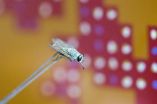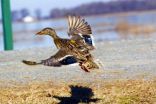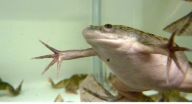(Press-News.org) A Brigham Young University ecologist is playing a role in the effort to curb a deadly disease affecting developing nations across equatorial Africa.
Steven L. Peck, a BYU professor of biology, has lent his expertise in understanding insect movement to help shape a UN-sanctioned eradication effort of the tsetse fly—a creature that passes the fatal African sleeping sickness to humans, domestic animals, and wildlife.
Using Peck's advanced computer models, crews from the UN's Food and Agriculture Organization will know where to concentrate their efforts to eliminate the highest number of tsetse flies. Early trials in Senegal have resulted in 99.6 percent of the flies being knocked out in treated blocks of land.
The successful effort is detailed in the recent issue of the Proceedings of the National Academy of Sciences. According to the paper, the full target area selected in Senegal is planned to be cleared of tsetse flies by the end of 2016.
"By all measures, we had a very successful trial, which is extremely hard with tsetse flies because they're an amazingly complex insect to try and control," Peck said. "It was a big deal to see it work like this."
The tsetse fly is the main vector for Human African Trypanosomiasis (aka sleeping sickness), and spreads the disease by biting humans or animals. The disease affects the central nervous system and is fatal if untreated. For some forms of the disease, victims can reach the terminal stage before symptoms even start to show.
Scientists call the tsetse fly the 'poverty fly' because it is both fatal to humans and damages their ability to grow crops by killing off the animals they use to plow fields. According to Peck, who has been to Senegal three times now, "the effects of this disease are devastating."
"It's an issue that doesn't get a lot of attention, but it should," he said. According to the World Health Organization, trypanosomiasis is a major neglected disease, indicating that it doesn't get the same research funding or attention as other major diseases (such as malaria).
With help from Peck's and others' insights, eradication crews are producing lab-reared tsetse flies that have been treated with radiation to render them sterile, and then releasing them back into the wild to mate with wild flies. Follow up trap monitoring reveals a steep decline in the number of flies.
Given the progress in Senegal, FAO organizers now plan to implement similar eradication methods across sub-Saharan African as part of the Pan African Tsetse and Trypanosomiasis Eradication Campaign.
"The methodology is very efficient and will be deployed over the full area using a rolling carpet approach," said Jeremy Bouyer, lead researcher and Head of the Vectors team for the Senegalese Institute for Agricultural Research. "It can be replicated to other parts of Africa where tsetse populations are isolated, like the common tsetse belt between Mozambique and South Africa."
Co-researchers like Bouyer are high on Pecks' mathematical models and their ability to accurately map the spatial structure of tsetse populations. According to Bouyer, the consortium of researchers committed to the project plan on continued collaboration with Peck and BYU going forward.
Peck believes his models, including a massive simulation currently running on BYU's Fulton supercomputer, will be helpful in optimizing strategies to control the insects—and eventually scale-back the devastating disease.
"Our work has shown that we can tackle a very devastating disease," Peck said. "It gives hope that the fly can be eradicated and controlled to alleviate the poverty it causes."
INFORMATION:
Eradicating fatal sleeping sickness by killing off the tsetse fly
Human African trypanosomiasis devastates humans and livestock
2014-07-17
ELSE PRESS RELEASES FROM THIS DATE:
Investing in sexual and reproductive health of 10 to 14 year olds yields lifetime benefits
2014-07-17
WASHINGTON -- Age 10 to 14 years, a time when both girls and boys are constructing their own identities and are typically open to new ideas and influences, provides a unique narrow window of opportunity for parents, teachers, healthcare providers and others to facilitate transition into healthy teenage and adulthood years according to researchers from Georgetown University's Institute for Reproductive Health who note the lack worldwide of programs to help children of this age navigate passage from childhood to adulthood.
An estimated 1.2 billion adolescents live in the ...
Women's professional self-identity impacts on childcare balance, but not men's
2014-07-17
A new study finds that the more a woman self-identifies with her profession, the more paid hours she works and the less time she spends with the couple's children, but the more equal the childcare balance is between a couple.
However, the more a woman identifies herself with motherhood, the less time the father spends with the children.
And while the more a man self-identifies as a parent the more time he spends with children, this had no impact on the amount of time the woman spends on childcare – regardless of her self-identity.
The study, from Cambridge University's ...
Duck migration study reveals importance of conserving wetlands, MU researchers find
2014-07-17
COLUMBIA, Mo. – During the 2011 and 2012 migration seasons, University of Missouri researchers monitored mallard ducks with new remote satellite tracking technology, marking the first time ducks have been tracked closely during the entirety of their migration from Canada to the American Midwest and back. The research revealed that mallards use public and private wetland conservation areas extensively as they travel hundreds of miles across the continent. Dylan Kesler, an assistant professor of fisheries and wildlife in the College of Agriculture, Food and Natural Resources ...
National Xenopus resource at the MBL innovates new way to study proteins
2014-07-17
WOODS HOLE, Mass.— Proteomics, the study of large groups of proteins, can enhance our understanding of a wide range of organisms, with applications in medicine and developmental biology. Such analyses traditionally require a complete genome for the organism being studied in order to obtain a reference set of proteins. However, many organisms that hold potential for proteomic analysis do not yet have completely sequenced and well-interpreted genomes because the costs, in terms of both time and money, can be prohibitive. Xenopus laevis, the African clawed frog, is one such ...
Birdsongs automatically decoded by computer scientists
2014-07-17
Birdsongs automatically decoded by computer scientists
Scientists from Queen Mary University of London have found a successful way of identifying bird sounds from large audio collections, which could be useful for expert and amateur bird-watchers alike.
The analysis used recordings of individual birds and of dawn choruses to identify characteristics of bird sounds. It took advantage of large datasets of sound recordings provided by the British Library Sound Archive, and online sources such as the Dutch archive called Xeno Canto.
Publishing in the journal PeerJ, ...
Study shows how effects of starvation can be passed to future generations
2014-07-17
NEW YORK, NY — Evidence from human famines and animal studies suggests that starvation can affect the health of descendants of famished individuals. But how such an acquired trait might be transmitted from one generation to the next has not been clear. A new study, involving roundworms, shows that starvation induces specific changes in so-called small RNAs and that these changes are inherited through at least three consecutive generations, apparently without any DNA involvement. The study, conducted by Columbia University Medical Center (CUMC) researchers, offers ...
How does working part-time versus working full-time affect breastfeeding goals?
2014-07-17
Los Angeles, CA -- Breastfeeding is known to provide significant health benefits for both infants and their mothers. However, while many women intend to breastfeed despite returning to work, a new study finds that mothers who plan to breastfeed for at least three months but return to work full-time are less likely to meet their breastfeeding goals. Conversely, there is no association between women who return to work part-time and failure to reach the breastfeeding goal of at least three months. This new study was published today in the Journal of Human Lactation.
Studying ...
Improving the cost and efficiency of renewable energy storage
2014-07-17
A major challenge in renewable energy is storage. A common approach is a reaction that splits water into oxygen and hydrogen, and uses the hydrogen as a fuel to store energy. The efficiency of 'water splitting' depends heavily on a solid substance called a catalyst. However, only the surface of the catalyst acts on the reaction, while its bulk is inactive. This restricts how much catalyst can be used, and limits the efficiency of water splitting in energy systems. Publishing in Nature Communications, EPFL scientists have developed a new method for maximizing the catalyst's ...
For the sickest emergency patients, death risk is lowest at busiest emergency centers
2014-07-17
ANN ARBOR, Mich. — When a medical emergency strikes, our gut tells us to get to the nearest hospital quickly. But a new study suggests that busier emergency centers may actually give the best chance of surviving – especially for people suffering life-threatening medical crises.
In fact, the analysis finds that patients admitted to a hospital after an emergency had a 10 percent lower chance of dying in the hospital if they initially went to one of the nation's busiest emergency departments, compared with the least busy.
The risk of dying differed even more for patients ...
Best anticoagulants after orthopedic procedures depends on type of surgery
2014-07-17
Current guidelines do not distinguish between aspirin and more potent blood thinners for protecting against blood clots in patients who undergo major orthopedic operations, leaving the decision up to individual clinicians. A new analysis published today in the Journal of Hospital Medicine provides much-needed information that summarizes existing studies about which medications are best after different types of surgery.
Every year, hundreds of thousands of Americans undergo major orthopedic surgery such as hip and knee replacements and hip fracture repairs. Patients undergoing ...
LAST 30 PRESS RELEASES:
Numbers in our sights affect how we perceive space
SIMJ announces global collaborative book project in commemoration of its 75th anniversary
Air pollution exposure and birth weight
Obstructive sleep apnea risk and mental health conditions among older adults
How talking slows eye movements behind the wheel
The Ceramic Society of Japan’s Oxoate Ceramics Research Association launches new international book project
Heart-brain connection: international study reveals the role of the vagus nerve in keeping the heart young
Researchers identify Rb1 as a predictive biomarker for a new therapeutic strategy in some breast cancers
Survey reveals ethical gaps slowing AI adoption in pediatric surgery
Stimulant ADHD medications work differently than thought
AI overestimates how smart people are, according to HSE economists
HSE researchers create genome-wide map of quadruplexes
Scientists boost cell "powerhouses" to burn more calories
Automatic label checking: The missing step in making reliable medical AI
Low daily alcohol intake linked to 50% heightened mouth cancer risk in India
American Meteorological Society announces Rick Spinrad as 2026 President-Elect
Biomass-based carbon capture spotlighted in newly released global climate webinar recording
Illuminating invisible nano pollutants: advanced bioimaging tracks the full journey of emerging nanoscale contaminants in living systems
How does age affect recovery from spinal cord injury?
Novel AI tool offers prognosis for patients with head and neck cancer
Fathers’ microplastic exposure tied to their children’s metabolic problems
Research validates laboratory model for studying high-grade serous ovarian cancer
SIR 2026 delivers transformative breakthroughs in minimally invasive medicine to improve patient care
Stem Cell Reports most downloaded papers of 2025 highlight the breadth and impact of stem cell research
Oxford-led study estimates NHS spends around 3% of its primary and secondary care budget on the health impacts of heat and cold in England
A researcher’s long quest leads to a smart composite breakthrough
Urban wild bees act as “microbial sensors” of city health.
New study finds where you live affects recovery after a hip fracture
Forecasting the impact of fully automated vehicle adoption on US road traffic injuries
Alcohol-related hospitalizations from 2016 to 2022
[Press-News.org] Eradicating fatal sleeping sickness by killing off the tsetse flyHuman African trypanosomiasis devastates humans and livestock




